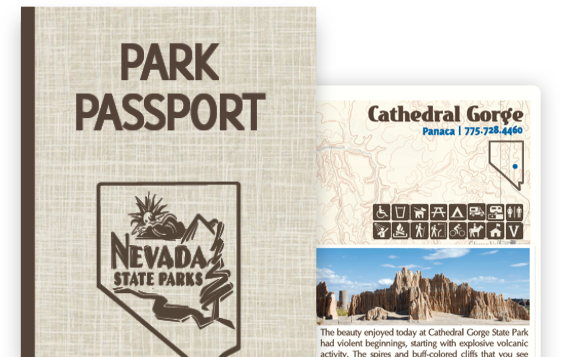-
x
Your Input Needed!
Help shape the future of outdoor recreation by filling out the Statewide Comprehensive Outdoor Recreation Plan survey.
Learn More
Dayton
State Park

About Dayton
At the foot of the Virginia Range, on the banks of the Carson River, Dayton State Park is rich in picturesque beauty as well as gold and silver mining history. The park features the remains of the Rock Point Mill built in 1861, a remnant of Dayton’s mining glory days. Old stone walls from the mill, one of the first to process ore from the Comstock Lode, still stand among cottonwood, sagebrush and willows. Originally a Paiute fishing camp, the park provides a scenic site to camp, picnic, hike or hold group outings. Visitors may catch a glimpse of one or more of the hawks, foxes or porcupines that call this beautiful park home.
FACILITIES & AMENITIES
Camping: There are ten campsites at the park that can accommodate 34' RVs, with picnic tables and barbecues. A dump station and restrooms with flush toilets are also available. The camping limit is seven days in a 30-day period.
Fishing: Catch-and-release bank fishing techniques are used to catch walleye, white bass, the hybrid wiper, catfish, trout and other game fish. The Nevada Department of Wildlife maintains fishing regulations. See a Health Warning from the Department of Wildlife on consumption of fish.
Group Area: The park features a shaded group-use area with 10 picnic tables, a sink, electricity, a large barbecue, a lawn area and plenty of parking. The area is available by reservation.
Picnicking/Day Use: Several picnic sites are located throughout the park and the cottonwood grove near the old mill site.
Hiking: Two short hikes can take you from the campground to the Carson River or to the Rock Mill Site.
Geocaching: Geocaching is a popular treasure hunt game using GPS coordinates. There are multiple caches hidden around the park. For more information, please visit geocaching.com.
Programs: Information about program scheduling may be obtained from either park staff or kiosks. Upon request, special presentations can be arranged for groups.
Hours: Open seven days a week, 365 days a year.
FIELD NOTES
- Pets are welcome, but they must be kept on a leash of not more than six feet in length.
- Collection of firewood within the park is not allowed.
- Fires are allowed only in the provided fire rings and barbecue pits.
- Swimming or playing in or near the canals and head gates is dangerous and is not allowed.
- Drive only on established roads. All vehicles and drivers must be licensed.
- Removing, disturbing or damaging any historic structure, artifact, rock, plant life, fossil or other feature is prohibited. State and federal laws protect this area and its resources.
- Hunting is not permitted in the park.
- Quiet hours are from 10 p.m. to 7 a.m.
- The use of drones or any remote controlled aircraft is not allowed. Visit B4UFLY for more info.
- Visitors are responsible for knowing all park rules and regulations in effect. Detailed rules and regulations are posted at the park or may be viewed on the Park Rules page.
- Those with developmental and/or physical limitations are invited to enjoy all of the recreational activities of Nevada State Parks. If you would like to request additional support or accommodations, please call the Nevada State Parks division office. We continually seek ways to provide recreational opportunities for people of all abilities and welcome any suggestions you may have.
- View a list of frequently asked questions.
NATURAL RESOURCES/CLIMATE
Dayton State Park consists of 160 acres with typical Great Basin desert topography, such as cottonwoods, sage, rabbitbrush and willows. The lower park borders the Carson River. The upper park includes the remains of old Highway 50 and the Rock Mill site and looks out over Dayton Valley at the foot of the Virginia mountain range. Cottontails and ground squirrels are plentiful, while an observant visitor may see a hawk, coyote, fox, mule deer or porcupine. Dayton summer temperatures range from 80-100˚F with lows around 40-50˚F. The park is 12 miles east of Carson City on U.S. 50.
HISTORY OF DAYTON STATE PARK – Established in 1977
Once a traditional Paiute meeting place, Dayton was used as a base camp for fishing on the Carson River and as a winter camp, sheltered from the snows of the nearby Sierra. The discovery of silver and gold changed that forever. In 1849, Abner Blackburn, during a stopover on his way to the California gold fields, was the first to find gold. Legend has it he used a hunting knife and a frying pan to prospect. It was not a rich strike, however, and as California beckoned, Abner and his friends moved on. (READ MORE)
get outdoors
Find a Park Event
push your boundaries
Explore More Nevada State Parks

Washoe Lake
With breathtaking views of the Sierra Nevada and Virginia mountain ranges, Washoe Lake is a popular area for hiking, camping, water sports, picnicking and equestrian activities. Bird watchers delight in the diversity of migratory birds and waterfowl.
- Quick Look
- Full Park Detail

Washoe Lake
Carson City, Nevada- Amenities
- View Description
- Full Park Detail

Mormon Station
Mormon Station is the site of Nevada’s first permanent, non-native settlement. A replica of the original trading post, built in 1851, houses a museum with pioneer-era artifacts. Large, lush lawns and mature trees make the park a lovely location to picnic.
- Quick Look
- Full Park Detail

Mormon Station
Genoa, Nevada- Amenities
- View Description
- Full Park Detail

Fort Churchill
An Army post built in 1861, Fort Churchill helped guard the Pony Express route and acted as a base for hundreds of soldiers. Visitors today can walk designated trails to study the ruins and can camp, picnic and enjoy fishing and swimming in the Carson River.
- Quick Look
- Full Park Detail

Fort Churchill
Silver Springs, Nevada- Amenities
- View Description
- Full Park Detail



